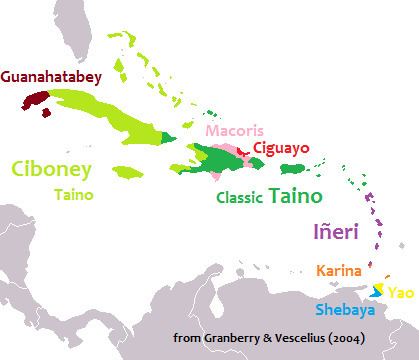Extinct 16th century ISO 639-3 tnq | Dialects Classic TaínoCiboney | |
 | ||
Ethnicity Taíno, Ciboney, Lucayan Language family ArawakanNorthernTa-ArawakanTaíno | ||
Taíno is an extinct and poorly attested Arawakan language historically spoken by the Taíno people of the Caribbean. At the time of Spanish contact, it was the principal language throughout the Caribbean. Classic Taíno (Taíno proper) was the native language of the northern Leeward Islands, Puerto Rico, the Turks and Caicos Islands, and most of Hispaniola, and was expanding into Cuba. Ciboney is essentially unattested, but colonial sources suggest it was a dialect of Taíno. It was the language of westernmost Hispaniola, the Bahamas, Jamaica, and most of Cuba.
Contents
By the late 15th century, Taíno had displaced earlier languages except for western Cuba and pockets in Hispaniola. As the Taíno culture declined during Spanish colonization, the language was replaced with Spanish and other European languages. It was extinct within a hundred years of contact. The language possibly continued to be spoken in isolated pockets in the Caribbean until the late 19th century. As the first native language encountered by Europeans in the New World, it was a major source of new words borrowed into European languages.
Dialects
Granberry & Vescelius (2004) distinguish two dialects, one on Hispaniola and further east, and the other on Hispaniola and further west.
The Lucayo (Bahamian) subdialect (or perhaps the Ciboney dialect) had /n/ where other dialects (or perhaps Classic Taíno) had /r/. There is variation in accounts between "e" ~ "i" and "o" ~ "u", perhaps reflecting transcription of the three stable vowels of Arawakan into the five vowels of Spanish.
Phonology
The Taíno language was not written. (The Taínos used petroglyphs, which may be interpreted as "pre-writing" or proto-writing.) However there has been little research in this area. The following phonemes are reconstructed from Spanish records:
There was also a flap [ɾ], which appears to have been an allophone of /d/.
A distinction between /ɛ/ and /e/ is suggested by Spanish transcriptions of e vs ei/ey, as in ceiba "ceiba". The /e/ is written ei or final é in modern reconstructions. There was also a high back vowel [u], which is often interchangeable with /o/ and may have been an allophone.
There was a parallel set of nasal vowels. The only consonant which could occur at the end of a syllable or a word was /s/.
Grammar
Taíno is very poorly attested. Nouns appear to have had noun-class suffixes as in other Arawakan languages. Attested Taíno possessive prefixes are da- 'my', wa- 'our', ni- 'his' (sometimes with a different vowel), and ta- 'her'.
Attested verbs are ka 'be', ka 'kill', ibá 'go', hiya 'speak', ã 'hear', (a)rikẽ (/dikɛ̃/?) 'see', ya 'do', bu 'be important'. Verb-designating affixes are a-, ka-, -a, -ka, -nV (where "V" is an unknown or variable vowel). A few conjugated verbs, da-ka "I am", wa-ibá "we go", and wa-rikẽ "we see" suggest that verbal conjugation for subject resembled the possessive prefixes on nouns. The one attested object suffix is -wo 'us', as in ahiyaka-wo 'speak to us'. The negative prefix is ma-, as in ma-kabuka 'it is not important'.
Taíno words in English
As the language of first contact, Taíno was one of the most important sources of Native American vocabulary in Spanish, involving hundreds of words for unfamiliar plants, animals, and cultural practices, and through Spanish to other European languages such as French and English. Below is a list of several English words derived from the Taíno language:
Place names
Taíno etymologies of place names:
The following are the major geographic features of the Caribbean, with their Taíno names (Carrada 2003):
